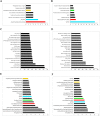Secreted proteomes of different developmental stages of the gastrointestinal nematode Nippostrongylus brasiliensis
- PMID: 24994561
- PMCID: PMC4188999
- DOI: 10.1074/mcp.M114.038950
Secreted proteomes of different developmental stages of the gastrointestinal nematode Nippostrongylus brasiliensis
Abstract
Hookworms infect more than 700 million people worldwide and cause more morbidity than most other human parasitic infections. Nippostrongylus brasiliensis (the rat hookworm) has been used as an experimental model for human hookworm because of its similar life cycle and ease of maintenance in laboratory rodents. Adult N. brasiliensis, like the human hookworm, lives in the intestine of the host and releases excretory/secretory products (ESP), which represent the major host-parasite interface. We performed a comparative proteomic analysis of infective larval (L3) and adult worm stages of N. brasiliensis to gain insights into the molecular bases of host-parasite relationships and determine whether N. brasiliensis could indeed serve as an appropriate model for studying human hookworm infections. Proteomic data were matched to a transcriptomic database assembled from 245,874,892 Illumina reads from different developmental stages (eggs, L3, L4, and adult) of N. brasiliensis yielding∼18,426 unigenes with 39,063 possible isoform transcripts. From this analysis, 313 proteins were identified from ESPs by LC-MS/MS-52 in the L3 and 261 in the adult worm. Most of the proteins identified in the study were stage-specific (only 13 proteins were shared by both stages); in particular, two families of proteins-astacin metalloproteases and CAP-domain containing SCP/TAPS-were highly represented in both L3 and adult ESP. These protein families are present in most nematode groups, and where studied, appear to play roles in larval migration and evasion of the host's immune response. Phylogenetic analyses of defined protein families and global gene similarity analyses showed that N. brasiliensis has a greater degree of conservation with human hookworm than other model nematodes examined. These findings validate the use of N. brasiliensis as a suitable parasite for the study of human hookworm infections in a tractable animal model.
© 2014 by The American Society for Biochemistry and Molecular Biology, Inc.
Figures








Similar articles
-
Proteomic characterization and comparison of the infective and adult life stage secretomes from Necator americanus and Ancylostoma ceylanicum.PLoS Negl Trop Dis. 2025 Jan 20;19(1):e0012780. doi: 10.1371/journal.pntd.0012780. eCollection 2025 Jan. PLoS Negl Trop Dis. 2025. PMID: 39832284 Free PMC article.
-
A newly identified secreted larval antigen elicits basophil-dependent protective immunity against N. brasiliensis infection.Front Immunol. 2022 Aug 25;13:979491. doi: 10.3389/fimmu.2022.979491. eCollection 2022. Front Immunol. 2022. PMID: 36091065 Free PMC article.
-
Comprehensive analysis of the secreted proteome of adult Necator americanus hookworms.PLoS Negl Trop Dis. 2020 May 26;14(5):e0008237. doi: 10.1371/journal.pntd.0008237. eCollection 2020 May. PLoS Negl Trop Dis. 2020. PMID: 32453752 Free PMC article.
-
Twenty-five-year research progress in hookworm excretory/secretory products.Parasit Vectors. 2020 Mar 14;13(1):136. doi: 10.1186/s13071-020-04010-8. Parasit Vectors. 2020. PMID: 32171305 Free PMC article. Review.
-
The role of ILC2 in hookworm infection.Parasite Immunol. 2018 Feb;40(2). doi: 10.1111/pim.12429. Epub 2017 May 22. Parasite Immunol. 2018. PMID: 28369954 Review.
Cited by
-
Structural and evolutionary insights into astacin metallopeptidases.Front Mol Biosci. 2023 Jan 4;9:1080836. doi: 10.3389/fmolb.2022.1080836. eCollection 2022. Front Mol Biosci. 2023. PMID: 36685277 Free PMC article.
-
Host Immunity and Inflammation to Pulmonary Helminth Infections.Front Immunol. 2020 Oct 20;11:594520. doi: 10.3389/fimmu.2020.594520. eCollection 2020. Front Immunol. 2020. PMID: 33193446 Free PMC article. Review.
-
Secreted venom allergen-like proteins of helminths: Conserved modulators of host responses in animals and plants.PLoS Pathog. 2018 Oct 18;14(10):e1007300. doi: 10.1371/journal.ppat.1007300. eCollection 2018 Oct. PLoS Pathog. 2018. PMID: 30335852 Free PMC article. Review.
-
The Secretome of Adult Murine Hookworms Is Shaped by Host Expression of STAT6.Parasite Immunol. 2024 Jul;46(7):e13056. doi: 10.1111/pim.13056. Parasite Immunol. 2024. PMID: 39073185 Free PMC article.
-
Altering the intracellular trafficking of Necator americanus GST-1 antigen yields novel hookworm mRNA vaccine candidates.PLoS Negl Trop Dis. 2025 Jan 10;19(1):e0012809. doi: 10.1371/journal.pntd.0012809. eCollection 2025 Jan. PLoS Negl Trop Dis. 2025. PMID: 39792959 Free PMC article.
References
-
- Hotez P. J., Brooker S., Bethony J. M., Bottazzi M. E., Loukas A., Xiao S. (2004) Hookworm infection. N. Engl. J. 351, 799–807 - PubMed
-
- Hotez P. J., Fenwick A., Savioli L., Molyneux D. H. (2009) Rescuing the bottom billion through control of neglected tropical diseases. Lancet 373, 1570–1575 - PubMed
-
- World Health Organization. Global Health Estimates (GHE) 2013: DALYs by age, sex and cause. DALY estimates, 2000–2011. Geneva: World Health Organization, November 2013
-
- Camberis M., Le Gros G., Urban J., Jr. (2003) Animal model of Nippostrongylus brasiliensis and Heligmosomoides polygyrus. Current protocols in immunology / edited by John E. Coligan. [et al.] Chapter 19, Unit 19 12 - PubMed
Publication types
MeSH terms
Substances
Grants and funding
LinkOut - more resources
Full Text Sources
Other Literature Sources
Miscellaneous

